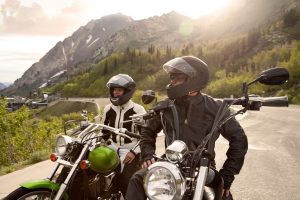When it comes to riding a motorcycle, it’s imperative to be wearing the right clothing gear so that you can be fully protected while riding, no matter your skill level. Hopefully you’ve been over the types of clothing you should wear and why they are important, but it’s also pertinent to note that everybody and every body is different. Here are a few tips for picking the right types of leather for you and your bike.
- Protectors – it’s important to make sure your leathers, your jacket and trousers, have extra protection around the back, chest, and arms, with integrated protectors that reinforce your leathers.
- Fit – an obvious point is that your gear should fit you. Try it on in the shop but make sure you move around enough. After all, you will be sitting down, leaning forwards, and twisting a lot in your outfit, so don’t just try it on standing up, do a full range of movements that will show you the real fit. It shouldn’t be too big or too small, but comfortable in a seated position with a little room to move. Extend your arms fully to see the sleeve length, too.
- Men vs women – make sure you accommodate for clothing that fits your gender. Motorcycle clothing will be designed specifically for men or for women, for good reason. But every body is also different, so mix and match and keep trying on un
 til you’re comfortable and covered.
til you’re comfortable and covered. - Price – while it may be tempting to save a few pennies on cost, generally you get what you pay for, so don’t scrimp. Cheaper price means cheaper quality, unless you’ve found a good events sale.
- Thickness and quality – this often depends on the type of riding you will be doing, but it’s usually recommended to stay above 1.1mm in thickness. Do you prefer lighter or heavier? What time of year and climate do you ride in? Kangaroo leather stays on the lighter side, while calfskin and goatskin should be at least 1.2mm in thickness. Check stitching too, the more stitching there is, the cheaper it is likely to be.
- Maintenance – once you’ve purchased your leathers, keep your receipt and any instructions that come with them for maintenance care. This usually involves a leather balm or vaseline to keep the quality high and functional by locking in the moisture that makes it so effective in the first place.
So next time you go into a shop to buy your leathers, don’t be afraid to ask some questions, have a good feel of the product, try it on properly, and take the time to make a decision. It’s better to go over your doubts in the shop that in a crash, after all.




